Use of electronic devices while driving
Part 3.1 of the Motor Vehicle Act prohibits the use of hand-held electronic devices while driving.
The Use of Electronic Devices While Driving Regulation are rules about how drivers must use permitted devices.
This page shows examples of banned and permitted devices. It also illustrates how permitted devices are to be used.
Complete ban - all drivers
A driver must not:
- Hold, operate, communicate or watch the screen of a hand-held electronic communication device
- Send or receive text messages or email on any type of electronic device, or
- Hold, operate, communicate or watch the screen of a hand-held electronic computing device, one of the purposes of which is to process or compute data
These prohibitions do not apply if the driver is:
- Safely parked and off the roadway, or
- Making an emergency call to 911
Complete ban - graduated licensing program driver
Drivers in the graduated licensing program are prohibited from using any electronic device while driving. This includes:
- Navigation devices
- Hands-free units, and
- Permitted devices
These prohibitions do not apply if the graduated licensing program driver is:
- Safely parked and off the roadway, or
- Making an emergency call to 911
Permitted uses - all drivers except for Class 7 graduated licensing driver
Hands-free communication
Manual dialing is prohibited and is treated as texting. Any type of an electronic device with a hands-free telephone function may be used for oral communications (including texting by dictation) if all the following conditions are met:
- The device, and any part or extension of it, is not held or operated by the hand, except for one touch to start, accept and/or end a call
- Any further operations performed with the device are voice-activated
- Any earpieces used with the device are worn in one ear only and are placed in the ear before driving*
- The device is securely fixed to the vehicle or worn securely on the person’s body, and is within easy reach of the driver’s seat
- The device is installed so it does not obstruct the driver’s view of the front or sides of the motor vehicle or interfere with the safety or operating equipment of the motor vehicle
*Motorcyclists are exempt from the one ear rule and may have an earpiece in both ears.
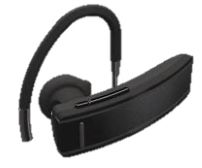
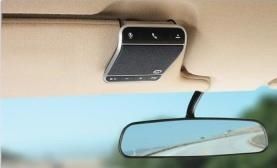
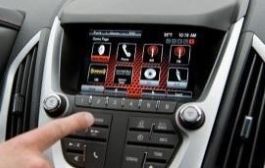
Hand-held audio players
A person may listen to sound from a hand-held audio player if:
- It is not held in the person’s hand
- It is securely fixed to the motor vehicle or worn securely on the person’s body in a manner that does not obstruct the person’s view of the front or sides of the vehicle or interfere with the safety or operating equipment of the vehicle, and
- It emits the sound through the speakers of the vehicle’s sound system
Please note: The driver may pre-program or set the device to play while the vehicle is safely parked and off the roadway.
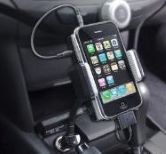
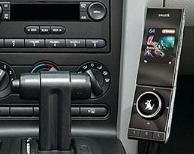
Navigation systems
A person may use a global positioning system (GPS) for navigation while driving if:
- It is programmed before the person drives or operates the vehicle
- It can be programmed in a voice-activated manner
- It is not be held in the hand, and
- It is securely fixed to the motor vehicle in a manner that does not obstruct the person’s view of the front or sides of the motor vehicle or interfere with the safety or operating equipment of the vehicle
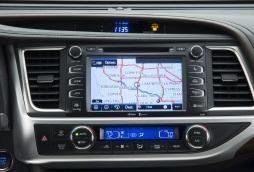
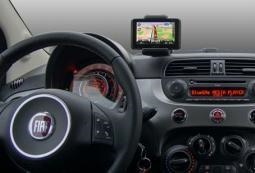
Hand microphones
A “hand microphone” is a ½ duplex communication device used principally for commercial purposes.
It is a hand-held unit that:
- Is both receiver and microphone
- Is operated by a push and hold-to-talk function
- Allows for oral communication, but not for the transmission and receipt of oral communication at the same time
A person may use a hand microphone while driving if:
- It is within easy reach of the driver’s seat, and
- It is securely fixed to the motor vehicle or worn securely on the person’s body in a manner that does not obstruct the person’s view of the front or sides of the vehicle or interfere with the safety or operating equipment of the motor vehicle
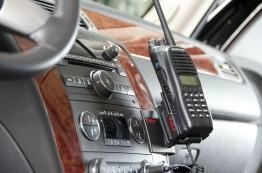
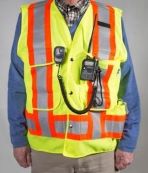
Two-way radios
“Two-way radios” are ½ duplex VHF, UHF and HF communication devices transmit sound over a radio frequency.
Two-way radios are commonly used by:
- Search and rescue teams
- Commercial drivers
- Long-haul truck drivers, and
- Citizen band (CB) and amateur radio operators
They have a hand-held microphone connected to a transceiver unit and it is operated by a push and hold-to-talk function and allows for oral communication. They do not allow for the transmission and receipt of oral communication at the same time.
A person may use a two-way radio while driving if the transceiver:
- Is within easy reach of the driver’s seat, and
- Is securely fixed to the motor vehicle or worn securely on the person’s body in a manner that does not obstruct the person’s view of the front or sides of the motor vehicle or interfere with the safety or operating equipment of the motor vehicle
Please note: Hand microphones, including two-way radios, may only be used in the push and hold-to-talk function while driving. Other functions on these devices cannot be operated by a driver while driving.
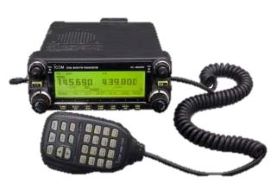
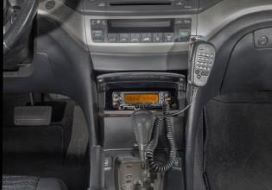
Television screens
A person may not have a television image displayed within view of the driver unless the image displays pictures, information or data solely designed to assist the driver in the safe operation of the vehicle or the safety and security of its load or its passengers.
The device must be installed so that it is securely fixed to the motor vehicle and in a manner that does not obstruct the driver’s view of the front or sides of the motor vehicle or interfere with the safety or operating equipment of the motor vehicle.

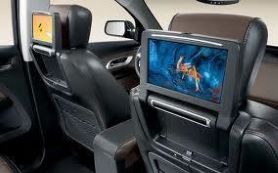
Devices allowed for use by industry or by licensed amateur radio operators
Mobile data terminals
Mobile data terminals are non-hand-held computerized devices without a telephone function that are licensed through Innovation, Science and Economic Development Canada under the Radiocommunication Act.
These devices are used only to communicate with a dispatcher or control centre and where pre-packaged data are transmitted, point in time, over a set radio frequency.
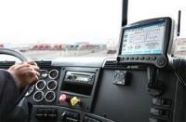
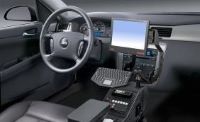
Fines and penalties
Graduated Licensing Program (GLP) drivers
GLP drivers are not permitted to use any electronic device.
The use of any prescribed electronic device within the meaning of the legislation, including use of a hands-free communication device or other electronic device will result in a $368 fine and 4 penalty points
All drivers
The use of an electronic device that is not allowed for in legislation but that does not involve texting, emailing or dialing (such as talking on a handheld cell phone) will result in a $368 fine and 4 penalty points
The use of an electronic device for communicating with another person or another device by email or other text-based message (such as texting, emailing or dialing) will result in a $368 fine and 4 penalty points
See ICBC’s Driver Penalty Point Premium web page for more information.
Please note: Offences carrying penalty points can lead to a driving prohibition under the authority and discretion of the Superintendent of Motor Vehicles.
If the driver is in the Novice stage, the 24 month Novice period starts again from the beginning once the prohibition is complete and the driver’s licence is returned to the driver.
Drivers who have two or more distracted driving tickets in a three year period will pay a Driver Risk Premium and could see their total financial penalties rise to as much as $2,000 – an increase of $740 over the existing penalties.
This is in addition to their regular insurance premium.
See ICBC’s Driver Risk Premium web page for more information.
